Babies
Good Things in Du Pont Cellophane
Things you can wrap in Du Pont cellophane: fresh fruits, vegetables, babies...Source: Saturday Evening Post, 1955 - via Hagley Digital Archives
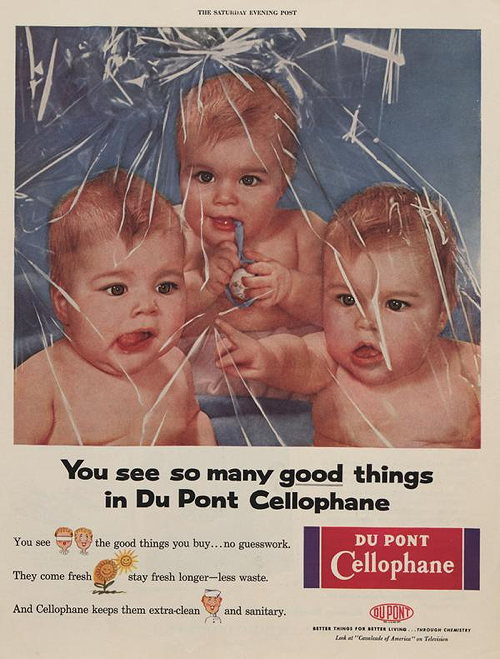
Posted By: Alex - Fri Nov 26, 2021 -
Comments (3)
Category: Babies, Advertising, 1950s
St. Rumwold—the youngest saint
Due to the vagaries of medieval spelling, Rumwold is also known as Rumald, Rumbold, Grumbald, Rumbald, etc. The story goes that Rumwold was born in 662 and only lived for three days. But during that brief time he demonstrated the ability to speak and recited the Lord's Prayer. So, after his death, he was made a saint.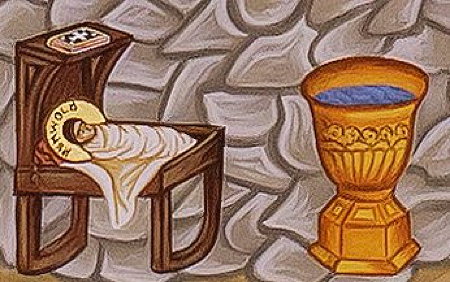
image source: .johnsanidopoulos.com
While a three-day-old saint is, on its own, odd enough, my favorite part of his story involves the picture of him that later hung in Boxley Abbey in Kent. It was used as a test of a woman's chastity. Those who were chaste would easily be able to lift the picture. But if a woman was not chaste, the picture would mysteriously become so heavy that she wouldn't be able to lift it.
The secret, unknown by those trying to lift the picture, was that it could be held in place (or not) by a wooden rod concealed behind it.
The story of the unliftable portrait is told by Sidney Heath in Pilgrim Life in the Middle Ages (1911):
His image at Boxley is said to have been small, and of a weight so light that a child could lift it, but that it could at times become so heavy that it could not be moved by persons of great strength.
Thomas Fuller, the quaint old divine, tells us that "the moving hereof was made the conditions of women's chastity. Such who paid the priest well might easily remove it, whilst others might tug at it to no purpose. For this was the contrivance of the cheat — that it was fastened with a pin of wood by an invisible stander behind. Now, when such offered to take it who had been bountiful to the priest before, they bare it away with ease, which was impossible for their hands to remove who had been close-fisted in their confessions. Thus it moved more laughter than devotion, and many chaste virgins and wives went away with blushing faces, leaving (without cause), the suspicion of their wantonness in the eyes of the beholders; whilst others came off with more credit (because with more coin), though with less chastity."
Posted By: Alex - Mon Nov 01, 2021 -
Comments (2)
Category: Babies, Hoaxes and Imposters and Imitators, Religion, Medieval Era
Howard makes clothes for men who make babies
Howard was a New York clothes store for men. The theme of their 1966 ad campaign was that they made clothes for virile men.The ad claiming that they made clothes "for men who make babies" was refused by every New York paper except the Times, which ran it once, and then never again, due to a complaint from the "Improvement of Advertising Content Committee".
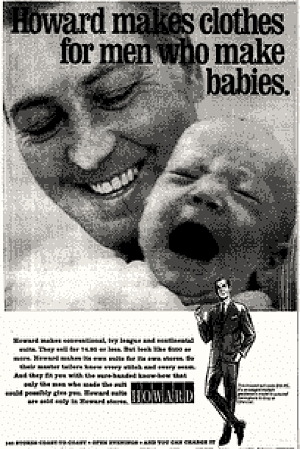
New York Times - Mar 4, 1966
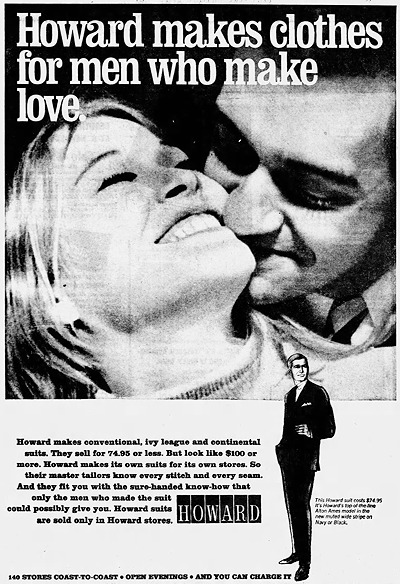
NY Daily News - Mar 3, 1966
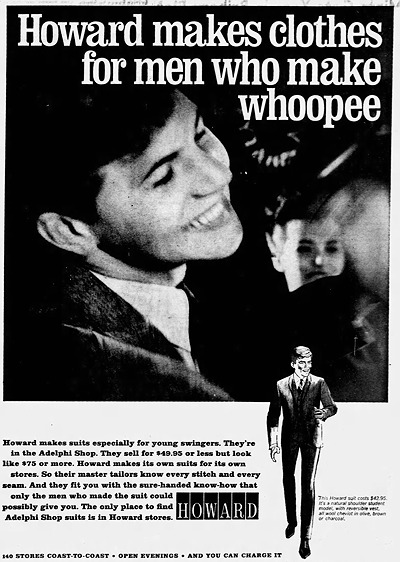
NY Daily News - Mar 24, 1966
Posted By: Alex - Sun Oct 24, 2021 -
Comments (1)
Category: Babies, Advertising, 1960s, Men
The Twilight Sleep Association
Rendering a pregnant woman unconscious in the delivery room is pretty much frowned upon nowadays, except for emergencies. But at one point, it was regarded as the newest sophistication of the birthing process.Article from 1915 here.
Modern essay here.
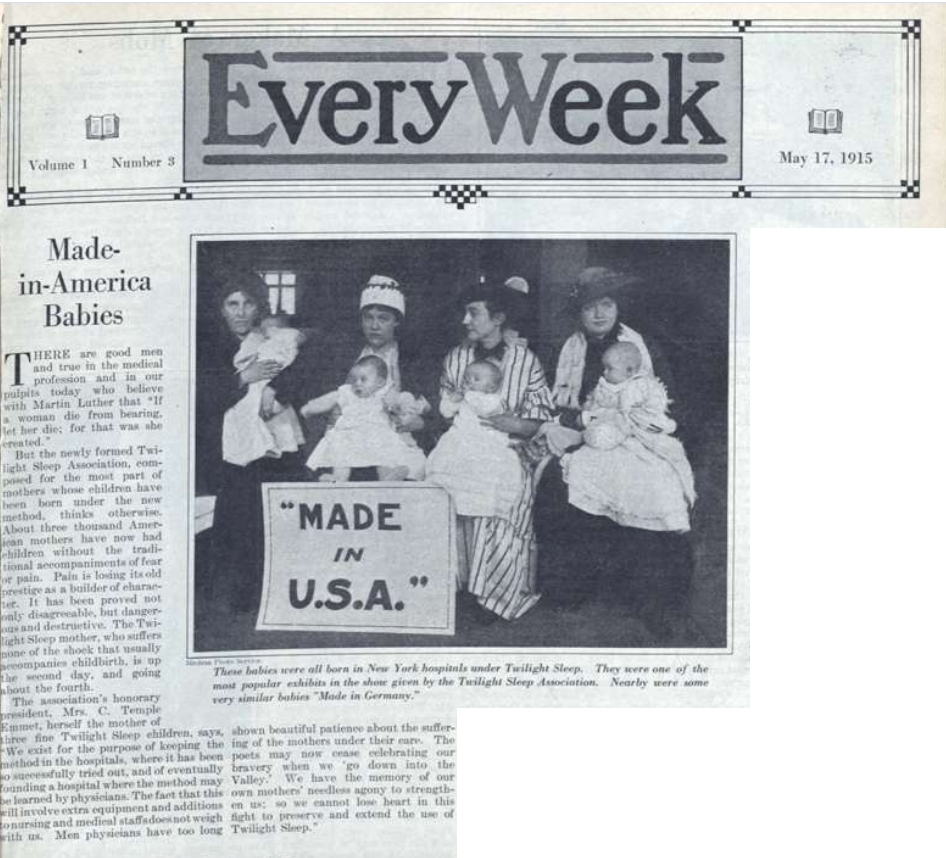
Source.
Posted By: Paul - Thu Apr 15, 2021 -
Comments (0)
Category: Babies, Medicine, Twentieth Century
Dancing on the Moon
Posted By: Paul - Wed Apr 14, 2021 -
Comments (1)
Category: Anthropomorphism, Babies, Cartoons, 1930s, Sex Lives Worse Than Yours
The Kiddie-Koop
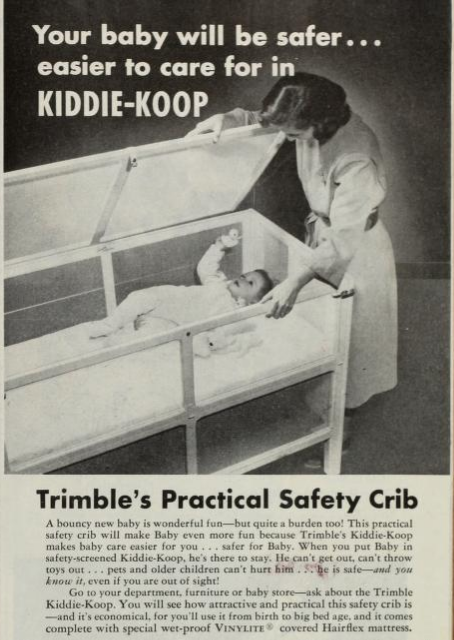

Children in cages!
Source.
Posted By: Paul - Mon Apr 05, 2021 -
Comments (2)
Category: Babies, Domestic, Inventions, Chindogu, Advertising, 1950s
Sounds of the Unborn
Musician Luca Yupanqui is releasing her first album, Sounds of the Unborn, in April.Though she had some help from her parents. Luca was still in her mother's womb when her parents recorded her in utero using electrodes and then used "biosonic MIDI technology" to transform the sounds into something like music.
It's being promoted as the "world’s first LP made from sounds inside the womb".
More info: The Guardian
Posted By: Alex - Tue Feb 16, 2021 -
Comments (1)
Category: Babies, Music
Use your children as dumbbells
Harold J. Reilly, owner of a New York gym during the 1930s and 40s, promoted the idea of using children as exercise equipment. Pick them up and swing them around, he urged parents, as one would a dumbbell or kettlebell.The advantage of using kids as dumbbells, he pointed out, was that as they grow older their weight will increase, thereby naturally helping the parents to develop their strength.
It's an intriguing idea, although a set of dumbbells is a lot cheaper than having children. And won't break if you drop them.
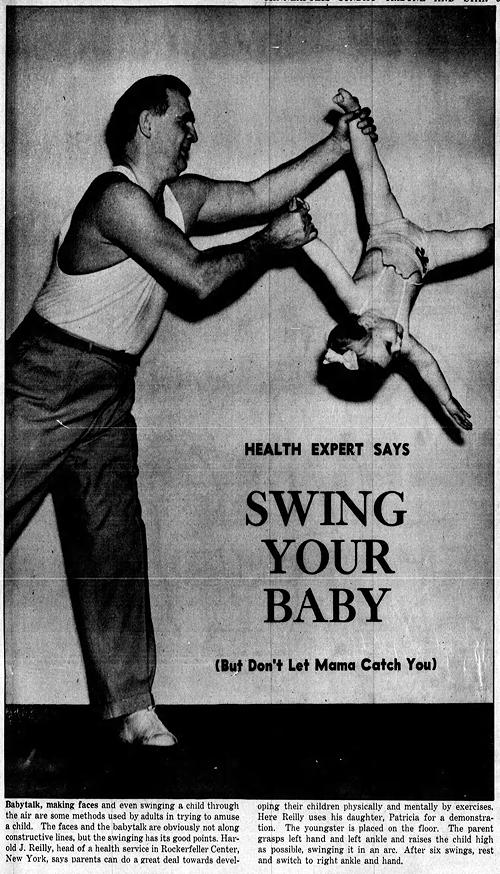
Minneapolis Star - May 31, 1942
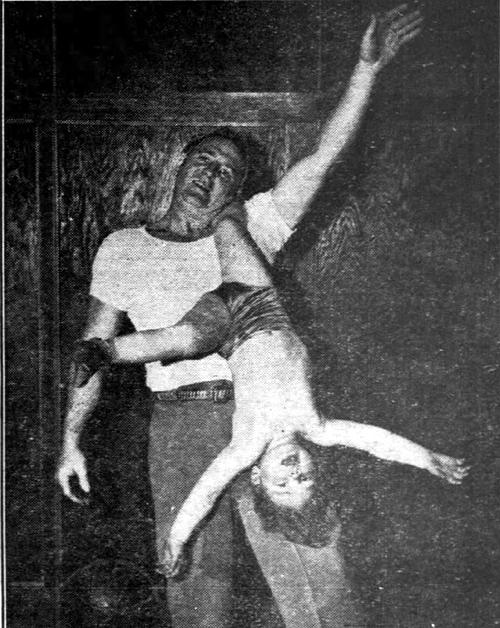
"Reilly recommends that parents (or grandparents) work out by swinging their youngsters around from childhood. Says it helps both out."
NY Daily News - May 2, 1948
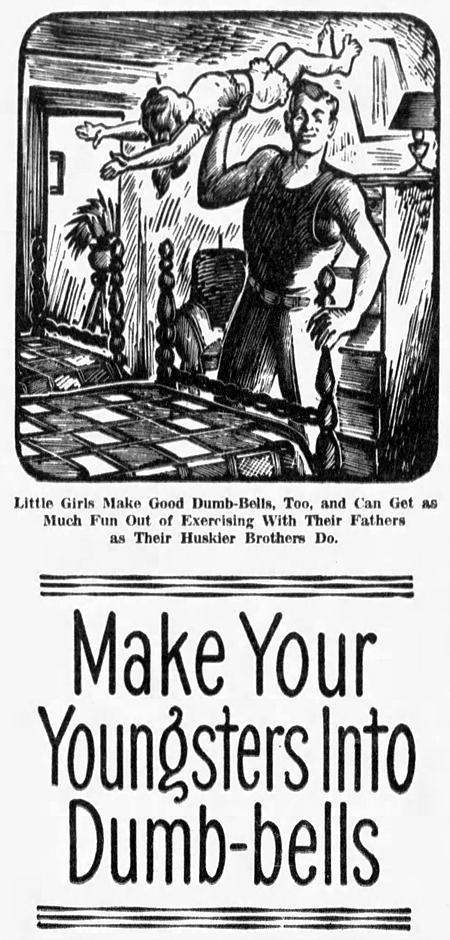
Pittsburgh Sun-Telegraph - Aug 3, 1941
Some years ago Mr. Reilly was thumbing through a volume of Greek mythology when he read how Hercules, as a boy, started lifting a small calf every day. As the calf grew, so did Hercules' strength so that when it became a full-grown bull Hercules could still lift it.
Mr. Reilly thought that the story could be given a modern twist and proceeded to do so. He became "Hercules" and his infant son and daughter the small "calves."...
For years he carried out this theory conscientiously with his own children and it worked so well that it prompted him to write a recent book about physical culture in which he advocates that both fathers and children will benefit greatly if the former raise the latter as dumb-bells.
"I'm not suggesting that you bring a bull calf into the house and go to work on it. After all you're not Hercules," Mr. Reilly points out in "The Secret of Better Health," published by Carlyle House, "But you can work out the same idea by starting to exercise with your pride and joy when he's only a year old, and keeping it up until he's ten, 15 or even 20. The child will benefit, and so will you...
"You may start when your child is an infant," says Mr. Reilly. "But as babies are delicate, don't begin by wrestling with him. Just manipulate the baby's arms and legs. Wiggle them around, being careful not to twist harshly... Then as the child begins to walk, you can swing him by the arms."...
"From three to six, you can become a little more strenuous. Pick the child up and swing him around, holding him by the arms. Let him lie on his back and take his two hands in one of yours and his ankles in the other and swing him around that way, back and forth, sideways and between your legs as though he were a medicine ball...
Mr. Reilly says that the swinging-around game should be kept up during the six-to-nine period of the child's age. In addition he should be picked up by the ankles and walked around, wheelbarrow fashion...
"From nine to 15 keep up the same exercises, if you can, and begin to box and wrestle with him," says Mr. Reilly. "It is just as easy with a daughter, for a little girl is a natural tomboy. She doesn't begin to be a female until around 12 years when adolescence sets in. Then a certain amount of care is necessary. But until then, treat your daughter the same as your son."
Update: Found a video of a guy using his kids as weights.
Posted By: Alex - Tue Jan 26, 2021 -
Comments (4)
Category: Babies, Exercise and Fitness, Babies and Toddlers, Children, 1940s
The Rule of 87
This "Rule of 87" may have been true in the mid-twentieth century, but I'm guessing that the rise of fertility drugs played havoc with it.
I'll also note that the Minnesota Twins won the 1987 World Series. Coincidence?
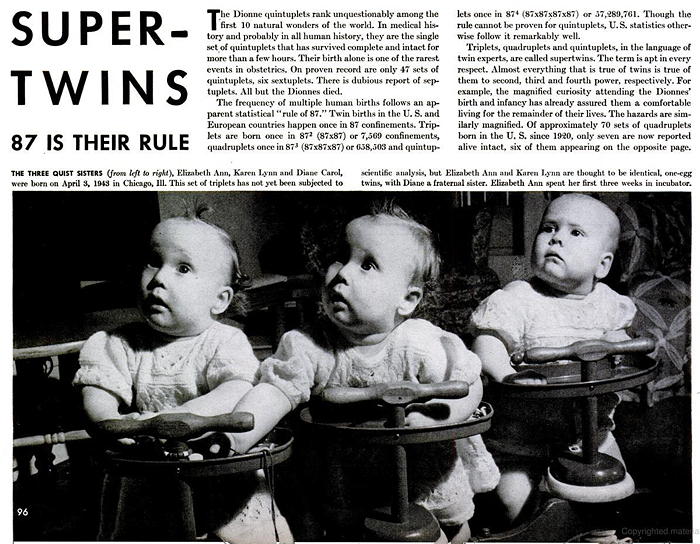
Posted By: Alex - Fri Oct 02, 2020 -
Comments (3)
Category: Babies, Science
Baby and Cockroach
In 2003, the UK children's charity Barnardo's came out with the ad below. It promptly triggered numerous complaints to the Advertising Standards Authority. Barnardo's argued that it "caused distress for good reason, but the ASA banned the ad anyway, saying it could "cause serious or widespread offense."The ad was subsequently voted one of the top 10 ads of 2003 by Campaign magazine.
Of course, the charity must have known it was likely the ad would get banned, but evidently figured the controversy would attract more attention to their message than something more subdued.
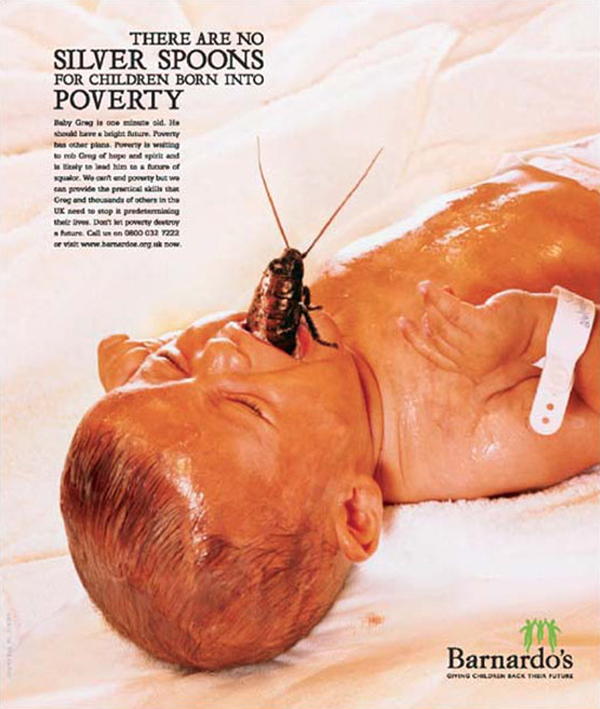
Posted By: Alex - Sat Aug 15, 2020 -
Comments (3)
Category: Babies, Charities and Philanthropy, Insects and Spiders, Advertising, Nausea, Revulsion and Disgust

| Who We Are |
|---|
| Alex Boese Alex is the creator and curator of the Museum of Hoaxes. He's also the author of various weird, non-fiction, science-themed books such as Elephants on Acid and Psychedelic Apes. Paul Di Filippo Paul has been paid to put weird ideas into fictional form for over thirty years, in his career as a noted science fiction writer. He has recently begun blogging on many curious topics with three fellow writers at The Inferior 4+1. Contact Us |




